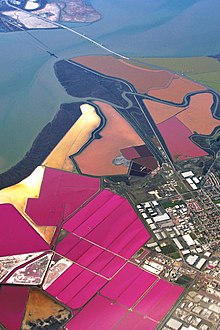Salt evaporation pond
A salt evaporation pond is a shallow artificial salt pan designed to extract salts from sea water or other brines. Natural salt pans are geological formations that are also created by water evaporating and leaving behind salts. Some salt evaporation ponds are only slightly modified from their natural version, such as the ponds on Great Inagua in the Bahamas, or the ponds in Jasiira, a few kilometres south of Mogadishu, where seawater is trapped and left to evaporate in the sun.
The seawater or brine is fed into large ponds and water is drawn out through natural evaporation which allows the salt to be subsequently harvested.
The ponds also provide a productive resting and feeding ground for many species of waterbirds, which may include endangered species.[1] The ponds are commonly separated by levees. Salt evaporation ponds may also be called salterns, salt works or salt pans.
Algae and color[]

Due to variable algal concentrations, vivid colors (from pale green to bright red) are created in the evaporation ponds. The color indicates the salinity of the ponds. Microorganisms change their hues as the salinity of the pond increases. In low- to mid-salinity ponds, green algae such as Dunaliella salina are predominant, although these algae can also take on an orange hue. In middle- to high-salinity ponds, Halobacteria, which is actually a group of halophilic Archaea (sometimes called Haloarchaea), shift the colour to pink, red and orange. Other bacteria such as Stichococcus also contribute tints.[citation needed]
Examples[]
Notable salt ponds include:
- The Salterns of Guérande, in Loire-Atlantique, France. The salt produced in the salterns are a protected geographical indication in Europe.
- The Cáhuil salt ponds, in the O'Higgins Region, Chile.
- The Salineras de Maras, Peru, in the Cusco Region.
- The saltworks of Alcácer do Sal, Comporta, and Castro Marim in Portugal
- The El Caracol solar evaporator, on the outskirts of Mexico City, Mexico.
- The Sečovlje and Strunjan salt ponds on the northern edge of the Adriatic Sea in Slovenia.
- The San Francisco Bay salt ponds in the United States, formerly operated by Cargill,[2][3][4][5] including Charleston Slough. Cargill has since ended salt production in the area, and most of the ponds are being restored to a more natural state.
- The Dead Sea salt ponds in the West Bank, Israel and Jordan.
- The salt ponds in Salina, Malta. The name of the village is the Maltese word for salt pan
- The Port Hedland, Dampier, Lake McLeod, Useless Loop and Onslow salt ponds in Western Australia.
- Yellow Walls, Malahide, Ireland; active from 1770 to 1837.[6]
- Lake Grassmere in New Zealand
- The salt pans in Marsala, Sicily. Salt has been farmed here since the Phoenician period, with archaeological evidence still present in nearby Motya.
- The salt works on the island of Great Inagua owned by Morton Salt.
- The salt harvesting by the Tsonga women of Baleni on the Small Letaba River, Limpopo, South Africa.[7]
Until World War II, salt was extracted from sea water in a unique way in Egypt near Alexandria.[8] Posts were set out on the salt pans and covered with several feet of sea water. In time the sea water evaporated, leaving the salt behind on the post, where it was easier to harvest.
Production[]
Salt pans are shallow open, often metal, pans used to evaporate brine. They are usually found close to the source of the salt. For example, pans used in the solar evaporation of salt from sea water are usually found on the coast, while those used to extract salt from solution-mined brine will be found near to the brine shaft. In this case, extra heat is often provided by lighting fires underneath.
Gallery[]
Natural salt evaporation ponds at Pedra de Lume, Sal island, Cape Verde
A salt pan worker in a salt evaporation pond in Tamil Nadu, India.

Contemporary solar evaporation salt pans on the island of Lanzarote at Salinas de Janubio

Solar evaporation ponds in the Atacama Desert
Solar evaporation ponds in the , Spain

Solar evaporation ponds in the , Spain
See also[]
- Solar desalination
- Seawater Greenhouse
- Evaporite
References[]
- ^ Athearn, Nicole D.; Takekawa, John Y.; and Shinn, Joel M. (2009) Avian response to early tidal salt marsh restoration at former commercial salt evaporation ponds in San Francisco Bay, California, USA, Natural Resources and Environmental Issues: Vol. 15, Article 14.
- ^ Napa Salt Pond Complex Archived 2011-08-19 at the Wayback Machine, The Bay Institute
- ^ Salt ponds, South San Francisco Bay, NASA Earth Observatory
- ^ "NASA Helps Reclaim 15,100 Acres Of San Francisco Bay Salt Ponds". Space Daily. Moffett Field. July 14, 2003.
- ^ "Archived copy". Archived from the original on 2011-08-07. Retrieved 2011-08-09.CS1 maint: archived copy as title (link)
- ^ https://oldyellowwalls.org/the-salt-works/
- ^ African Ivory Route. Transfrontier Parks Destinations https://www.africanivoryroute.co.za/cultural-camps/baleni-cultural-camp. Retrieved 11 September 2019. Missing or empty
|title=(help) - ^ Salt, Grown On Sticks Harvested From Sea, Popular Science, March 1933
External links[]
| Wikimedia Commons has media related to: Salt evaporation pond (category) |
- Ponds
- Salt production
- Economic geology
- Primitive technology
- Resource extraction









